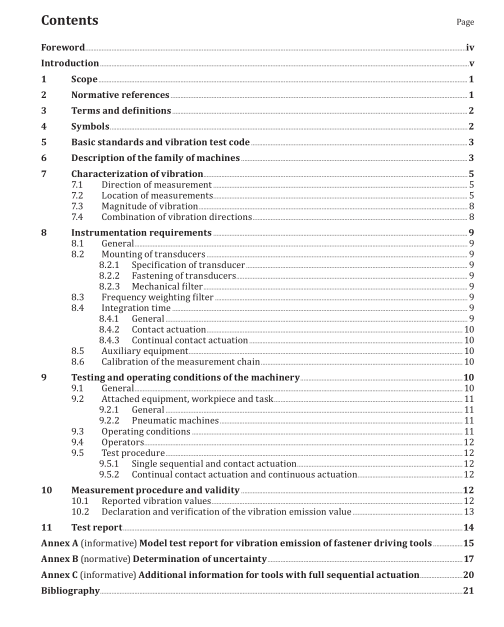ISO 28927-13:2022 pdf download.Hand-held portable power tools — Test methods for evaluation of vibration emission — Part 13: Fastener driving tools
8 Instrumentation requirements
8.1 General
The instrumentation shall be in accordance with ISO 20643:2005 and ISO 20643:2005/Amd 1:2012, 7.1.
8.2 Mounting of transducers
8.2.1 Specification of transducer
The specification for the transducer given in ISO 20643:2005 and ISO 20643:2005/Amd 1:2012, 7.2.1,applies.
The total mass of the transducers and mounting device shall be small enough, compared with that of the machine, handle, etc., so as not to influence the measurement result.
This is particularly important for low-mass plastic handles (see ISO 5349-2).
8.2.2 Fastening of transducers
The transducer or mounting block used shall be rigidly attached to the surface of the handle.
In case of soft grip handles the resilient material shall be removed to attach the transducer on the rigid surface.
Ideally for triaxial measurements, integrated triaxial transducers should be used. For the two axes aligned parallel to the vibrating surface, the measurement axes of the two transducers — or the two transducer elements in a triaxial transducer — shall be a maximum of 10 mm from the gripping surface.
8.2.3 Mechanical filter
It is normally necessary to use mechanical filters for measurements in accordance with this document to prevent dc shifts. For the application of mechanical filter see ISO 5349-2:2001, Annex C.
8.3 Frequency weighting filter
Frequency-weighting shall be in accordance with ISO 5349-1:2001.
8.4 Integration time
8.4.1 General
The integration time shall be in accordance with ISO 20643:2005 and ISO 20643:2005/Amd 1:2012, 7.4.
8.4.2 Contact actuation
Actuation shall be performed 10 times regularly distributed over an integral time of 30 s.
8.4.3 Continual contact actuation
The machine shall be set to 80 % of its maximum repetition speed of operation. If this is not possible, the machine shall be set to its maximum repetition speed of operation. The measurement shall be carried out over a duration of at least 8 s.
8.5 Auxiliary equipment
For pneumatic machines, the air pressure shall be measured using a pressure gauge with an accuracy equal to or better than 0,1 bar 1) .
For electrical machines, the voltage shall be measured using a voltmeter with accuracy equal to or better than 3 % of the actual value.
8.6 Calibration of the measurement chain
The specifications for calibration given in ISO 20643:2005 and ISO 20643:2005/Amd 1:2012, 7.6 apply.
9 Testing and operating conditions of the machinery
9.1 General
Measurements shall be carried out on a new, properly serviced and lubricated fastener driving tool.
The fastener driving tool shall be operated perpendicularly to the workpiece.
A suitable feed force shall be applied to ensure stable and smooth operation of the power tool and to give rated performance in accordance with the manufacturer’s specification.
During the test, the power tool shall be arranged so that the operator can have an upright, or almost upright, posture and work with his forearm and upper arm at an angle between 100° and 160°. The operator shall be able to hold the power tool comfortably during the test. See Figure 11.
9.2 Attached equipment, workpiece and task
9.2.1 General The pressure of compressed-air-operated fastener driving tools shall be adjusted so that the fasteners used are driven into the workpiece. Special cases shall be reported. The pressure used shall assure proper function of the fastener driving tool.
Non-compressed-air-operated fastener driving tools which are equipped with an impact force adjustment shall be regulated using this device. The power setting shall be adjusted to ensure that the fastener (staplers, nailers, etc.) are driven flush to the surface. When a tool is designed to install fasteners in materials other than wood, the manufacturer’s instructions shall be followed.
9.2.2 Pneumatic machines
The pressure of pneumatically powered fastener driving tools or other data related to the power supply shall be measured and kept constant during the test procedure. During testing, the pressure should be set according to the manufacturer recommendations such as the biggest fasteners are driven flush. The air pressure shall be measured and reported. For pneumatically driven tools, the air shall be supplied by a hose having a length of at least 2 m, which is attached to the power tool via a quick-action connector.
9.3 Operating conditions
During the measurement, the fastener driving tool shall operate with the longest fastener intended for the power tool. If the workpiece is made of pine wood then it should be free from knots and with a straight grain. The average bulk density shall be 0,42 g/cm 3 to 0,48 g/cm 3 and the average wood humidity shall be (12 ± 3) %. If the workpiece is made of steel then it should be using specifications in ISO 28927-5:2009 and ISO 28927-5:2009/Amd 1:2015, 8.4.1, Table 1. Drills without impact action. The thickness of the steel plate shall be at least 35 mm. The thickness of the workpiece shall be at least 1,2 times the length of the longest fastener used.
The point of insertion on the workpiece shall be at least 50 mm from the edge. When a tool is designed to install fasteners in materials other than wood, the manufacturer’s instructions shall be followed. The workpiece shall be supported by a bed of dry sand, with the grain of the wood in a horizontal position and so that the surface of the workpiece is on a level with the top of the sand. The sand bed dimensions shall be at least 600 mm × 600 mm × 400 mm. The workpiece shall be surrounded on all sides with a sand layer which is at least 120 mm wide. The surface of the workpiece should be arranged so that the geometric centre of the fastener driving tool is positioned approximately 1 m above the floor. See Figure 12.ISO 28927-13 pdf download.ISO 28927-13 pdf download
